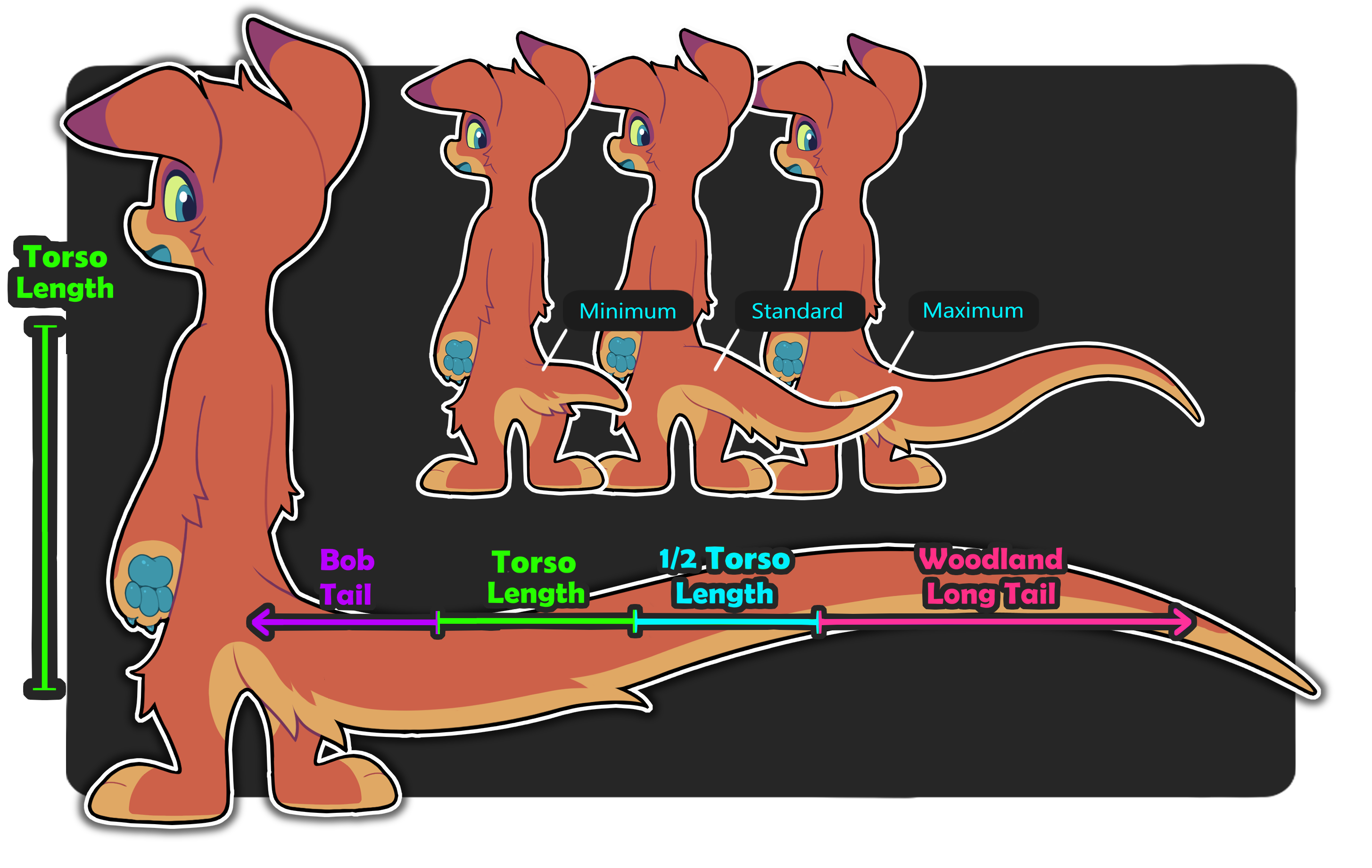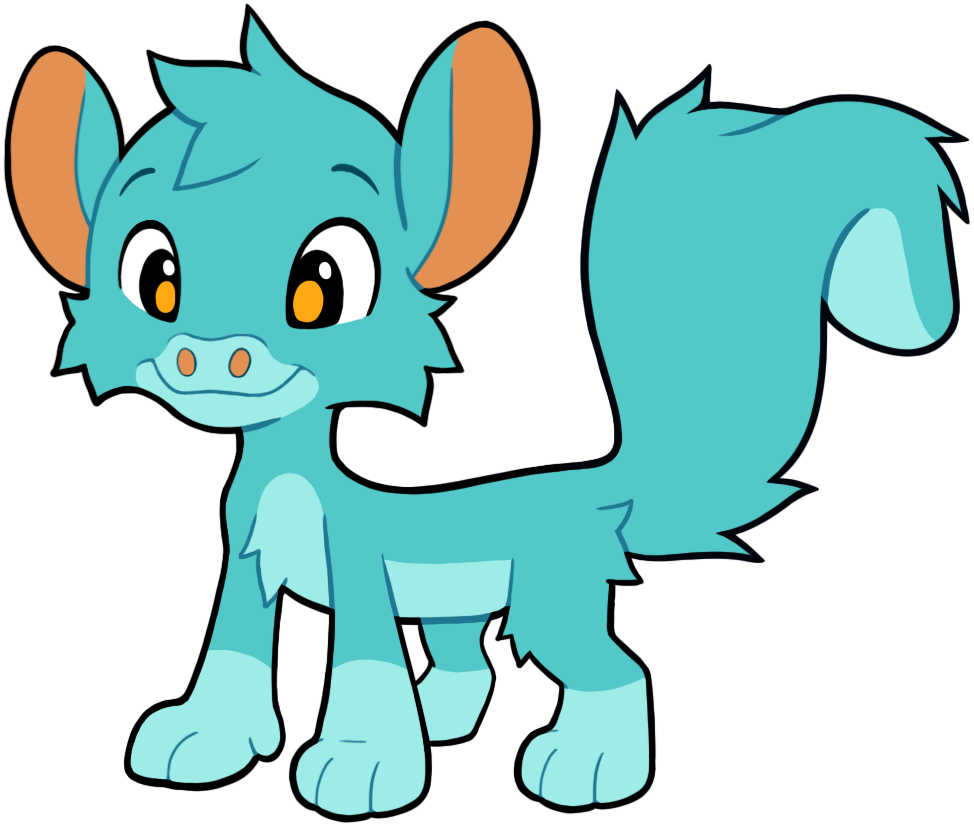Traits
Desert Tail (Desert)
Desert Xeros can have thick, fat tails like a gecko to store fat and water, this trait is known as a Desert Tail. Size and shape can vary, but think of a thick leopard gecko-like tail, or a big squishy tail reminiscent of a caterpillar or grub.
Tufted Tail (Standard)
Tufted Tails are a common mutation observed on Xeros. These tails can be any size or shape, but feature a tuft of longer fur at the tip, like a lion.
Bobtail (Notable)
Bobtails are a somewhat unusual mutation to see on a Xero. These tails are naturally short, and can be various shapes such as super short nubs, or fluffier bunny or deer-like tails.

Standard Xero tails can vary in length, with most being about the same length as their body. Anything longer than 1.5x the length of the Xero's torso would need to be defined as a Woodland Tail*. Anything shorter than half of the Xero's torso length would need the Bobtail trait instead!
A Xero's torso can be measured by drawing a line from the top of their shoulders to the crotch.
*This is subjective as not all art styles will be drawn with the same torso length. Ultimately, whether or not a Xero should have the Woodland Tail trait or Bobtail trait is up to staff discretion.
Prehensile Tail (Unusual)
Xeros can have all sorts of tail shapes, but prehensile tails are quite rare. This type of tail acts as a fifth limb, allowing the Xero to hold on to other objects or aid in climbing. When not in use, they hold their tails coiled tightly in a spiral, usually facing down.
Plume Tail (Unusual)

Plume tails are a somewhat unusual mutation to see on a Xero. These tails are are very flat and wide and can be smooth like a beaver's tail or long and fluffy like a skunk or squirrel's tail.
Ornamental Tail (Seasonal)
Ornamental Tail is a rare mutation observed on Xeros. This is a fancy tail tip made of hard keratin or cartilage. It can be almost any shape, as long as it’s placed on the end of the tail!
Canis Tail (Standard)
A common tail mutation observed on Xeros is the canis tail; these tails are fluffy and tapered with a pointed tip. They can range from scruffy dog-like tails to longer poofy fox tails.
How To Use This Trait
 Do
Do
- Fluffy dog, wolf, or fox-like tails with a pointed tip.
- Tail should have a tapered shape: thinner at the base and tip, thicker in the middle.
 Don't
Don't
- Thicker kangaroo-like tails should use Standard Tail. Thinner rounded noodle tails should use Felis Tail.
- Canis tails have a thin core and are mostly fur. Extra-thick tails should use the Desert Tail trait.
This trait can be added to your Xero by giving them a Bearded Cap.
Click the magnifying glass above for examples of this trait! 🔍
Felis Tail (Standard)
A common tail mutation observed on Xeros is the felis tail; a long noodle-shaped tail! These round-tipped tails aren't tapered and are roughly the same width all the way around.
How To Use This Trait
 Do
Do
- Felis tails include thin cat-like tails or poofier red panda tails.
- Tail should be roughly the same width all the way around, with very little tapering and a rounded tip.
 Don't
Don't
- Thicker kangaroo-like tails should use Standard Tail. Scruffy tails with a pointed tip should use Canis Tail.
- These tails should not be very pointy at the tip.
This trait can be added to your Xero by giving them an Affocato.
Click the magnifying glass above for examples of this trait! 🔍
Woodland Tail (Woodland)
A Woodland Xero's long tail is the perfect counterweight to help them balance up in the trees. They're also extremely handy in helping them wrap around tree trunks and branches when climbing. While useful for traversal, some Woodland Xeros have found that it can cause quite a tripping hazard in their day to day lives.

Standard Xero tails can vary in length, with most being about the same length as their body. Anything longer than 1.5x the length of the Xero's torso would need to be defined as a Woodland Tail*. Anything shorter than half of the Xero's torso length would need the Bobtail trait instead!
A Xero's torso can be measured by drawing a line from the top of their shoulders to the crotch.








